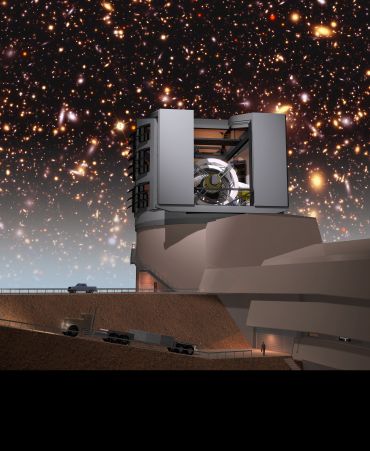The University of Oxford and the Breakthrough Prize Foundation today announced a new scientific partnership aimed at finding evidence of signatures of technology beyond our planet.
 Artist's illustration of the Vera Rubin Observatory with its dome open beneath a night sky filled with galaxies. Credit: Todd Mason, Mason Productions Inc.
Artist's illustration of the Vera Rubin Observatory with its dome open beneath a night sky filled with galaxies. Credit: Todd Mason, Mason Productions Inc.Oxford will be the international headquarters for the Breakthrough Listen initiative, the largest ever astronomical programme searching for 'technosignatures' - evidence of past or present technology that would signal the presence of life beyond planet Earth. The partnership will advance the scope and reach of the Listen programme, putting the UK at the forefront of this rapidly growing field, and inject significant resources into technology and software development at the University of Oxford's Department of Physics.
The University of Oxford's Department of Physics will be the new international headquarters for the Breakthrough Listen programme. Listen's arrival at Oxford will enhance existing research strands, introduce a new direction for research, and support significant technological innovation. This new partnership includes:
- Hardware, software, and theoretical advances in radio astrophysics, with a focus on the Square Kilometre Array, a global effort to deliver a transformational radio telescope array by 2030;
- The search for life on extrasolar planets, including a focus on our nearest neighbours;
- Detection of astrophysical transients and anomalies in optical transient surveys, including the vast new Legacy Survey of Space and Time (LSST) to be delivered by the Rubin Observatory from 2024;
- Development of new, cutting-edge machine learning techniques to search the vast amounts of incoming astronomical signals for anomalies;
- Exploring the possibility of using the lunar farside as an interference-free site for radio astronomy.
The program will continue to be led by Principal Investigator Dr Andrew Siemion as part of Oxford's Astrophysics sub-department. The partnership preserves existing relationships with UC Berkeley, the University of Manchester, the University of Cambridge, the SKA Observatory, the SETI Institute and other global partners.
Oxford has become a global leader in survey astronomy, the analysis of large-scale datasets, including in the very near future the incredible optical harvest we expect from the Vera Rubin Observatory. Working with Breakthrough Listen on these data will explore previously uncharted territory
Professor Ian Shipsey FRS, Head of Physics at the University of Oxford
Launched in July 2015, Breakthrough Listen is the most ambitious search for technosignatures ever undertaken. The programme has helped transform the search for extraterrestrial intelligence (SETI) into a rigorous scientific field. Its observations from a global network of the world's largest and most advanced radio telescopes have surveyed thousands of nearby stars, the Milky Way's galactic plane and centre, and dozens of nearby galaxies. The Listen team has developed innovative computer and artificial intelligence (AI) systems to digitize billions of radio channels at the same time, across a wide swath of the radio spectrum, and search them for candidate signals. Its more than 70 published papers include the careful analysis of signals of interest, the discovery of new astronomical objects (including 72 Fast Radio Bursts from a rare repeating emitter), and a first-of-its-kind "Exotica" list comprehensively cataloguing objects of astronomical interest.
The partnership with Oxford coincides with an exciting new phase for Breakthrough Listen. The team has recently started working with new data recorded by the MeerKAT telescope in South Africa. This 64-antenna array - a precursor for the Square Kilometre Array (SKA) - offers an unprecedented combination of sensitivity, resolution, and field of view on the sky, operating 24/7. The University of Oxford's Department of Physics is playing a leading role in developing instrumentation and software for both MeerKAT and the SKA, which - once complete - will be the world's foremost radio astronomy facility.
Breakthrough Listen will also use data from the Vera Rubin Observatory in Northern Chile (expected to be operational in 2024). This uses a 3200 megapixel camera, co-developed with Oxford's Department of Physics, to image the entire visible sky as seen from Cerro Pachon, Chile, every 3-4 nights, and is predicted to help discover about 20 billion galaxies and a similar number of stars.
We are delighted to launch a new era of Listen here at Oxford. This collaboration will be a tremendous fusion of knowledge, resources, and passion to understand our place in the cosmos.
Dr S. Pete Worden, Executive Director of the Breakthrough Initiatives
The Breakthrough Listen programme heavily leverages machine learning and AI to process its huge datasets; in January 2023, the project announced that a new AI-driven method had identified eight previously undetected potential technosignatures. By continuing to develop these tools for Breakthrough Listen, the programme has the potential to help deliver a step-change in big data capabilities that will have applications for a diverse range of industries.
Professor Rob Fender, Head of Astrophysics, Department of Physics, University of Oxford said: 'This is an extraordinarily exciting partnership, bringing a large-scale SETI programme to the UK which in turn greatly enhances our existing research programmes at Oxford. This move recognises how the University of Oxford's existing astrophysics programmes in radio astronomy instrumentation, astrophysical transients, and exoplanetary studies, make it the perfect base for Breakthrough Listen.'
Professor Lord Martin Rees FRS, The Astronomer Royal, Chair of Breakthrough Listen Advisory Committee, enthusiastically supports the partnership: 'It is extremely exciting to see this large SETI programme moving to a UK base. The search for extraterrestrial intelligence is one of mankind's greatest quests. I am delighted at the prospect of Breakthrough Listen being based at Oxford.'






